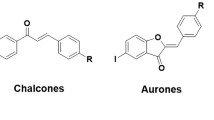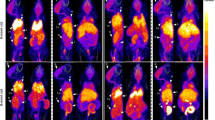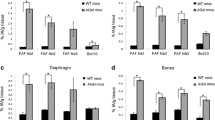Abstract
The potential utility of an imaging agent for the detection of hepatic copper was investigated in a Wilson’s disease animal model. Solid-phase peptide synthesis was used to construct an imaging agent which consisted of a copper-binding moiety, taken from the prion protein, and a gamma ray-emitting indium radiolabel. Long–Evans Cinnamon (LEC) rats were used for the Wilson’s disease animal model. Our evaluation methodology consisted of administering the indium-labeled agent to both LEC and genetically healthy Long–Evans (LE) cohorts via a tail vein injection and following the pharmacokinetics with single-photon emission computed tomography (SPECT) over the course of an hour. The animals were then sacrificed and their livers necropsied. An additional control agent, lacking the copper-binding moiety, was used to gauge whether any change in the hepatic uptake might be caused by other physiological differences between the two animal models. LEC rats injected with the indium-labeled agent had roughly double the amount of hepatic radioactivity as compared to the healthy control animals. The control agent, without the copper-binding moiety, displayed a hepatic signal similar to that of the control LE animals. Additional intraperitoneal spiking with CuSO4 in C57BL/6 mice also found that the pharmacokinetics of the indium-labeled, prion-based imaging agent is profoundly altered by exposure to in vivo pools of extracellular copper. The described SPECT application with this compound represented a significant improvement over a previous MRI application using the same base peptide sequence.




Similar content being viewed by others
References
Kitzberger, R., Madl, C., & Ferenci, P. (2005). Metabolic Brain Disease, 20, 295–302.
Terada, K., Nakako, T., Yang, X.-L., Iida, M., Aiba, N., Minamiya, Y., Nakai, M., Sakaki, T., Miura, N., & Sugiyama, T. (1998). Journal of Biological Chemistry, 273, 1815–1820.
Fatemi, N., & Sarkar, B. (2002). Metals Toxicity, 110, 695–698.
Roelofsen, H., Wolters, H., Van Luyn, M. J., Miuta, N., Kuipers, F., & Vonk, R. J. (2000). Gastroenterology, 119, 782–793.
Cater, M. A., Fontaine, S. L., Shield, K., Deal, Y., & Mercer, J. F. B. (2006). Gastroenterology, 130, 493–506.
Svetel, M., Pekmezović, T., Petrović, I., Tomić, A., Kresojević, N., Ješić, R., Kažić, S., Raičević, R., Stefanović, D., Delibašić, N., Živanović, D., Dordević, M., & Kostić, V. S. (2009). European Journal of Neurology, 16, 852–857.
DiDonato, M., Narindrasoradak, S., Forbes, J. R., Cox, D. W., & Sarker, B. (1997). Journal of Biological Chemistry, 272, 33279–33282.
Ala, A., Walker, A. P., Ashkan, K., Dooley, J. S., & Schilsky, M. L. (2007). Lancet, 369, 397–408.
Makino, S., Umemoto, T., Yamada, H., Yezdimer, E. M., & Tooyama, I. (2012). Applied Biochemistry and Biotechnology, 168, 504–518.
Okayasu, T., Tochimaru, H., Hyuga, T., Takahashi, Y., Takekoshi, Y., Li, Y., Togashi, Y., Takeichi, N., Kasai, N., & Arashima, S. (1992). Pediatric Research, 31, 253–257.
Fujiwara, N., Iso, H., Kitanaka, N., Kitanaka, J., Eguchi, H., Ookawara, T., Ozawa, K., Shimoda, S., Yoshihara, D., Takemura, M., & Suzuki, K. (2006). Biochemical and Biophysical Research Communications, 349, 1079–1086.
Kawano, H., Takeuchi, Y., Yoshimoto, K., Matsumoto, K., & Sugimoto, T. (2001). Brain Research, 915, 25–31.
Kim, J.-M., Ko, S.-B., Kwon, S.-J., Kim, H.-J., Han, M.-K., Kim, D. W., Cho, S. S., & Jeon, B. S. (2005). Neuroscience Letters, 382, 143–147.
Nair, J., Strand, S., Frank, N., Knauft, J., Wesch, H., Galle, P. R., & Bartsch, H. (2005). Carcinogenesis, 26, 1307–1315.
Kasper, C. B., Deutsch, H. F., & Beinert, H. (1963). Journal of Biological Chemistry, 238, 2338–2342.
Urbanski, N. K., & Beresewicz, A. (2000). Acta Biochimica Polonica, 47, 951–962.
Forrer, F., Valkema, R., Bernard, B., Schramm, N. U., Hoppin, J. W., Rolleman, E., Krenning, E. P., & deJong, M. (2006). European Journal of Nuclear Medicine and Molecular Imaging, 33, 1214–1217.
Rolleman, E. J., Bernard, B. F., Breeman, W. A., Forrer, F., deBlois, E., Hoppin, J. W., Gotthardt, M., Boerman, O. C., Krenning, E. P., & deJong, M. (2008). Nuklearmedizin, 47, 110–115.
Acknowledgments
This work was supported by a Grant-in-Aid for Research and Development of an Intellectual Infrastructure Project of the New Energy and Industrial Technology Development Organization (NEDO) of Japan and by a Grant-in-Aid for Scientific Research on Innovative Areas from the Ministry of Education, Science, Sports and Culture of Japan (I.T). The authors wish to sincerely thank Jack Hoppin, Jacob Hesterman, and Mary Germino at inviCRO, LLC (Boston, MA) for helping manage the SPECT studies and image processing.
Author information
Authors and Affiliations
Corresponding author
Rights and permissions
About this article
Cite this article
Yezdimer, E.M., Umemoto, T., Yamada, H. et al. Visualizing Hepatic Copper Release in Long–Evans Cinnamon Rats Using Single-Photon Emission Computed Tomography. Appl Biochem Biotechnol 170, 1138–1150 (2013). https://doi.org/10.1007/s12010-013-0252-9
Received:
Accepted:
Published:
Issue Date:
DOI: https://doi.org/10.1007/s12010-013-0252-9




